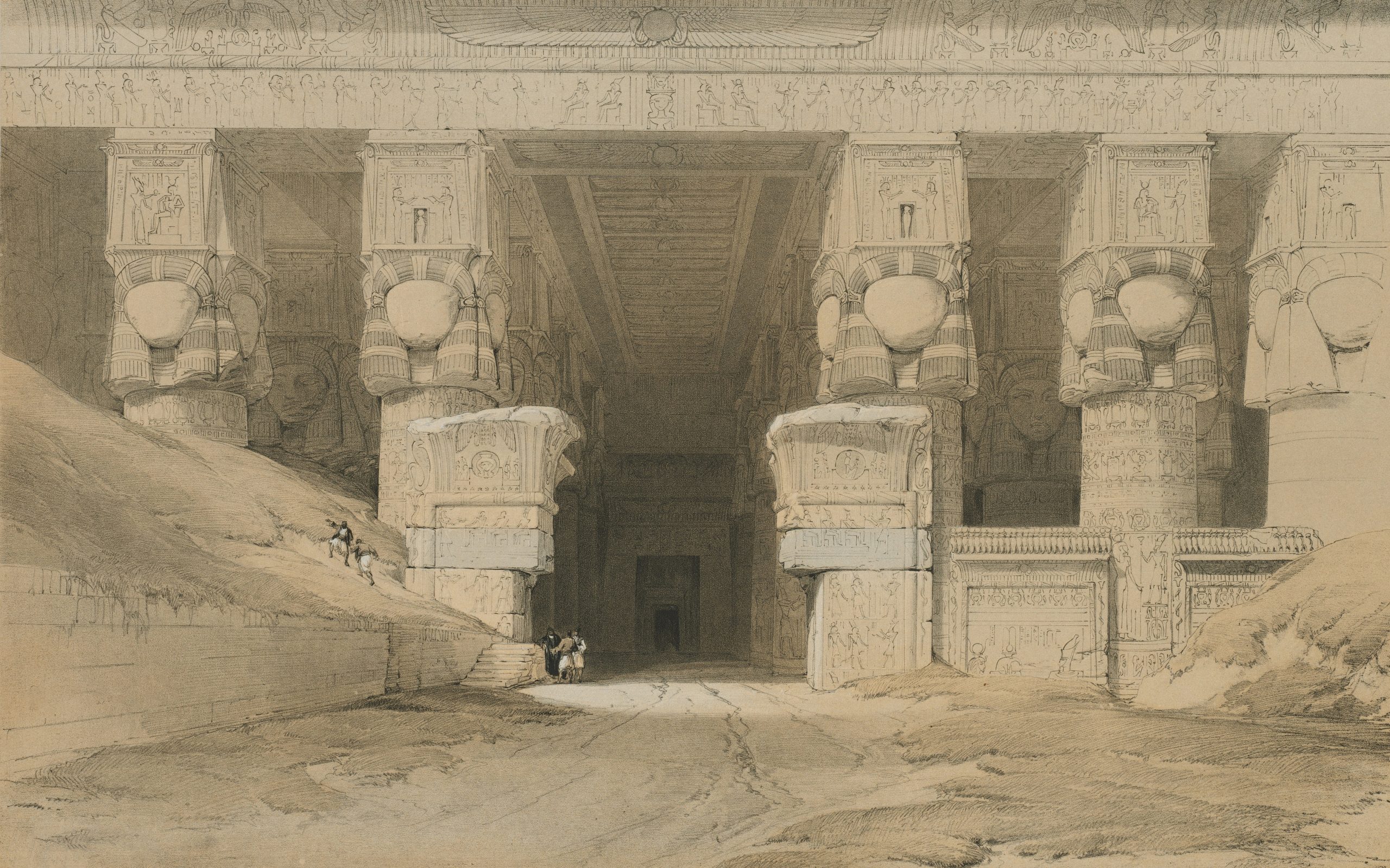This website uses cookies so that we can provide you with the best user experience possible. Cookie information is stored in your browser and performs functions such as recognising you when you return to our website and helping our team to understand which sections of the website you find most interesting and useful.

By admin on 15 Jun 2025
Tucked between Luxor and Aswan, Edfu Temple is one of Egypt’s best-preserved ancient wonders. Dedicated to Horus, the falcon god, this majestic site invites you to wander through towering columns and beautifully carved walls that bring ancient myths to life, especially the epic battles between Horus and Set.
Built over nearly two centuries during the Ptolemaic era, the temple is more than just stone—it’s a storybook in hieroglyphs, offering rare glimpses into religious rituals, political moments, and daily life thousands of years ago.
What makes Edfu truly special? It’s near-perfect preservation. Protected by layers of desert sand for centuries, it remains remarkably intact, so when you visit, you’re seeing it almost as the ancients did.
In this guide, we’ll walk you through what not to miss, the best times to visit, and tips to make the most of your journey into the heart of ancient Egypt.

Mythology and Legends of Edfu Temple
Edfu Temple holds deep historical and religious value, largely due to the rich mythology woven into its walls. Central to its narrative is the epic conflict between the falcon god Horus and his uncle Set, a battle rooted in vengeance and justice. As the son of Osiris and Isis, Horus sought to avenge his father’s murder at the hands of Set. Their struggle, ultimately resolved in a celestial court where Horus triumphed, symbolizes the triumph of order over chaos—a theme deeply ingrained in ancient Egyptian belief.. The battle between them, with numerous depictions in the reliefs of the temple, is considered a prototype of the struggle between order and chaos. Additionally, one of the most important annual festivals was the Feast of the Beautiful Meeting in Edfu, commemorating the divine marriage of Horus and Hathor. A statue of Hathor was brought from the nearby Temple of Dendera, symbolizing her visit to her consort, Horus. Finally, the festival and offerings at the temple emphasized fertility, renewal, and cosmic harmony, key to the role of the temple in society. Furthermore, Edfu Temple and its reliefs offer invaluable information about the religious and cultural peculiarities of Ancient Egypt. For example, the Foundation Ritual is a key depiction, describing the ceremonial event of the temple’s construction, with the pharaoh leading the trench-cutting operations. The Foundation Ritual’s reliefs allow one to visualize walking through these ceremonies, emphasizing the temple’s unique status as the gate to the mysteries of the divine.
How to Get to Edfu Temple Nowadays in 2025
Reaching Edfu is almost as much of an adventure as seeing the temple. The most popular way to see the temple is to take a Nile cruise. Most river cruises make stops in Luxor and Aswan. This journey is not only comfortable but also an exciting one that lets you enjoy the mild river breeze and admire the picturesque landscapes and historic landmarks that reside on the riverbanks.
However, if you prefer traveling by land, Edfu is accessible from both Luxor and Aswan by the main road.
The most common mode of transportation used to get from the cruise ship to the temple is by horse carriage, known locally as “Hantours.” These carriages are considered the most practical option compared to cars, especially given the uneven and winding nature of the road leading to the temple. The path isn’t fully paved or stable, making horse-drawn carriages a more comfortable and efficient way to reach the site.
Note: We would like to advise animal-conscious travelers that, unfortunately, animal welfare standards may not always be upheld in this area.
For this reason, we offer alternative transportation options to help ensure that no harm comes to animals and to provide a more ethical and comfortable travel experience for all our guests.
When’s the Best Time to Visit Edfu Temple?
Choosing the right time to visit the Edfu Temple can greatly enhance your experience. The most enjoyable weather typically falls between October and April, when daytime temperatures stay between 20°C and 30°C (68°F to 86°F). These milder months offer a more comfortable climate for walking around and exploring the site in depth. With cooler weather on your side, you’ll be free to roam the temple grounds at your own pace, taking in its impressive architecture and intricate carvings, without the discomfort of sweltering heat.
For the most magical experience, try visiting early in the morning or late in the afternoon. Not only will you avoid the intensity of the midday sun, but you’ll also enjoy fewer crowds. These times of day offer soft, golden lighting that casts a warm glow on the temple’s stonework, making the site feel even more enchanting—and perfect for photos!
One thing to keep in mind: national holidays and major Egyptian festivals often bring in larger crowds. If you’re after a quieter, more reflective visit, it’s best to steer clear of these busier times. But whether you’re soaking in the peaceful vibes of a quiet morning or joining in the festive energy, planning your visit thoughtfully will help you make the most of your journey to Edfu Temple.
What to Expect During Your Visit
Upon arriving at Edfu Temple, the towering pylons immediately impress, hinting at the grandeur within. Passing through the entrance, visitors step into a wide courtyard bordered by colonnades, each carved with scenes of pharaohs offering gifts to the gods. It’s a space that sets the tone—majestic yet intimate, steeped in ancient ritual.
Deeper inside lies the Hypostyle Hall, a vast chamber supported by massive columns adorned with lotus and papyrus motifs. Above, a ceiling painted with celestial scenes evokes a sense of cosmic wonder. The shifting light and deep shadows create an atmosphere both solemn and awe-inspiring, evoking the presence of worshippers long gone.
At the temple’s core is the Holy of Holies, once home to a statue of Horus. Though the statue no longer remains, the chamber still feels sacred, quiet, reflective, and powerful. Around it, smaller chapels honor other deities, their walls rich with carvings that offer insight into ancient Egyptian beliefs. A visit to Edfu is not just a journey through stone and history—it’s a step into a deeply spiritual past.
Conclusion: Embracing the Legacy of Edfu Temple
Edfu Temple is more than a relic—it’s a vivid reminder of the depth and brilliance of ancient Egyptian culture. With its towering architecture, detailed reliefs, and spiritual echoes, it offers visitors a rare chance to feel truly connected to a distant past.
Walking through its halls isn’t just sightseeing; it’s an invitation to witness how a civilization honored its gods and preserved its beliefs in stone. Every carving, every chamber, holds a piece of a story that still resonates today.
Whether you’re drawn by history, architecture, or a simple curiosity about the ancient world, Edfu Temple delivers an experience that lingers long after you leave. It’s a journey into a time of awe, artistry, and enduring legacy—one well worth taking.
Categories
- Egypt and Jordan Tours (12)
- Egypt Destinations (26)
- Egypt Nile Cruises (40)
- Egypt Sightseeing (14)
- Egypt Tour Packages (18)
- infographics (1)
-

Nile Cruisers Reviews
25 Mar 2025
-

Egypt Safari Trips in Siwa & White Desert
20 Dec 2025
-

Why Choose Nile Cruisers to Book Your Egypt Nile Cruise?
12 Dec 2025
-

Celebrate Christmas in Egypt: Best Egypt Travel Tour Packages for Year-End Getaways
12 Dec 2025
-

Make Your Year-End Special: Festive Egypt Tour Packages for Winter Travel
12 Dec 2025
-

The Lake Nasser Luxury Cruise Ships
09 Dec 2025
-

Sacred Egypt – Spiritual Tours
07 Dec 2025
-

Nile Cruisers Reviews
25 Mar 2025
-

Egypt Safari Trips in Siwa & White Desert
20 Dec 2025
-

Why Choose Nile Cruisers to Book Your Egypt Nile Cruise?
12 Dec 2025
-

Celebrate Christmas in Egypt: Best Egypt Travel Tour Packages for Year-End Getaways
12 Dec 2025
-

Make Your Year-End Special: Festive Egypt Tour Packages for Winter Travel
12 Dec 2025












Comments